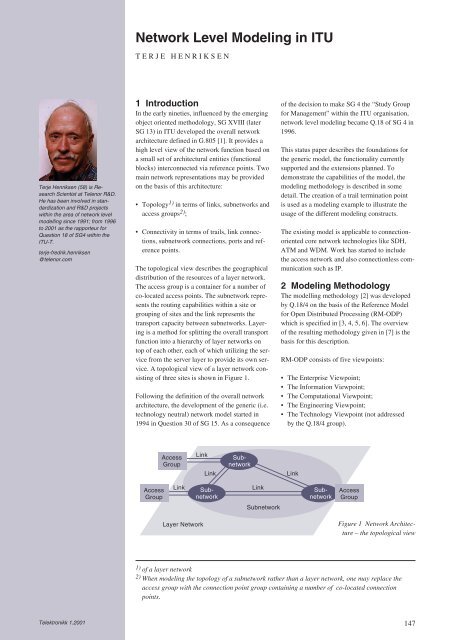You also want an ePaper? Increase the reach of your titles
YUMPU automatically turns print PDFs into web optimized ePapers that Google loves.
Terje Henriksen (58) is Research<br />
Scientist at <strong>Telenor</strong> R&D.<br />
He has been involved in standardization<br />
and R&D projects<br />
within the area of network level<br />
modelling since 1991; from 1996<br />
to 2001 as the rapporteur for<br />
Question 18 of SG4 within the<br />
ITU-T.<br />
terje-fredrik.henriksen<br />
@telenor.com<br />
Telektronikk 1.2001<br />
Network Level Modeling in ITU<br />
TERJE HENRIKSEN<br />
1 Introduction<br />
In the early nineties, influenced by the emerging<br />
object oriented methodology, SG XVIII (later<br />
SG 13) in ITU developed the overall network<br />
architecture defined in G.805 [1]. It provides a<br />
high level view of the network function based on<br />
a small set of architectural entities (functional<br />
blocks) interconnected via reference points. Two<br />
main network representations may be provided<br />
on the basis of this architecture:<br />
• Topology 1) in terms of links, subnetworks and<br />
access groups 2) ;<br />
• Connectivity in terms of trails, link connections,<br />
subnetwork connections, ports and reference<br />
points.<br />
The topological view describes the geographical<br />
distribution of the resources of a layer network.<br />
The access group is a container for a number of<br />
co-located access points. The subnetwork represents<br />
the routing capabilities within a site or<br />
grouping of sites and the link represents the<br />
transport capacity between subnetworks. Layering<br />
is a method for splitting the overall transport<br />
function into a hierarchy of layer networks on<br />
top of each other, each of which utilizing the service<br />
from the server layer to provide its own service.<br />
A topological view of a layer network consisting<br />
of three sites is shown in Figure 1.<br />
Following the definition of the overall network<br />
architecture, the development of the generic (i.e.<br />
technology neutral) network model started in<br />
1994 in Question 30 of SG 15. As a consequence<br />
Access<br />
Group<br />
Access<br />
Group<br />
Link<br />
Subnetwork<br />
Link Link<br />
Link Subnetwork<br />
Link<br />
Subnetwork<br />
of the decision to make SG 4 the “Study Group<br />
for Management” within the ITU organisation,<br />
network level modeling became Q.18 of SG 4 in<br />
1996.<br />
This status paper describes the foundations for<br />
the generic model, the functionality currently<br />
supported and the extensions planned. To<br />
demonstrate the capabilities of the model, the<br />
modeling methodology is described in some<br />
detail. The creation of a trail termination point<br />
is used as a modeling example to illustrate the<br />
usage of the different modeling constructs.<br />
The existing model is applicable to connectionoriented<br />
core network technologies like SDH,<br />
ATM and WDM. Work has started to include<br />
the access network and also connectionless communication<br />
such as IP.<br />
2 Modeling Methodology<br />
The modelling methodology [2] was developed<br />
by Q.18/4 on the basis of the Reference Model<br />
for Open Distributed Processing (RM-ODP)<br />
which is specified in [3, 4, 5, 6]. The overview<br />
of the resulting methodology given in [7] is the<br />
basis for this description.<br />
RM-ODP consists of five viewpoints:<br />
• The Enterprise Viewpoint;<br />
• The Information Viewpoint;<br />
• The Computational Viewpoint;<br />
• The Engineering Viewpoint;<br />
• The Technology Viewpoint (not addressed<br />
by the Q.18/4 group).<br />
Subnetwork<br />
Access<br />
Group<br />
Layer Network Figure 1 Network Architecture<br />
– the topological view<br />
1) of a layer network<br />
2) When modeling the topology of a subnetwork rather than a layer network, one may replace the<br />
access group with the connection point group containing a number of co-located connection<br />
points.<br />
147

















